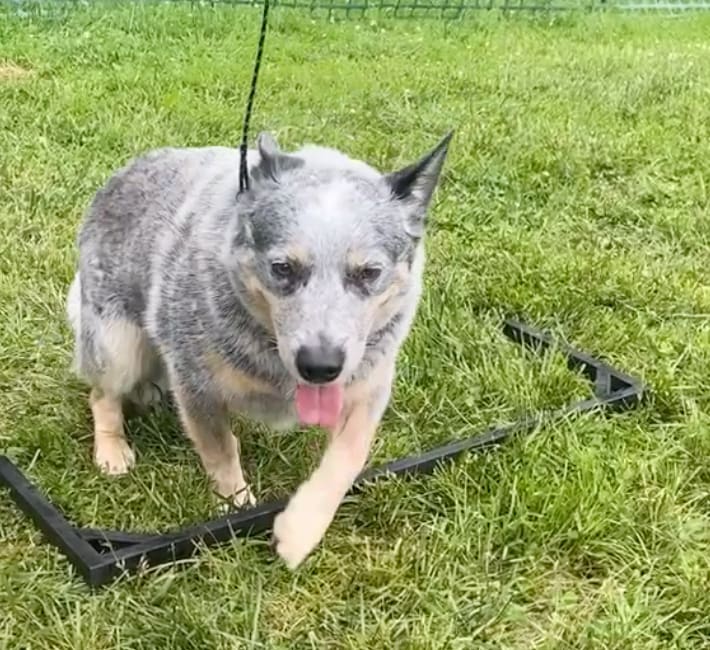Did you know that, just like humans, dogs can have limb dominance or paw preference when doing simple tasks like walking or reaching for something? Many owners may observe their dogs starting a variety of activities without realizing that they have a limb preference. Just like when a human always takes their first step when walking, they favor one foot over the other. Currently, there is no genetic test to determine paw preference like body traits in dogs, but there are other ways to determine paw preference in your dog.
At the Westminster Kennel Club Dog Show in June 2021, Embark scientists and veterinarians had an opportunity to collect data to conduct field tests to determine if the diversity of dogs at Westminster is also present in their paw preferences. Recent canine research showed that 58.3% of dogs had a right paw preference, while recent human research found that 90% of people are right-handed. Embark scientists set up a booth inviting dogs to take a variety of tests including the step test, the crate test, and the tape test.
The step test is used to determine which paw your dog uses first when beginning to walk from a still position (sitting or standing); that is, the first paw to step over the stick.

The crate test is used to determine which direction your dog turns to face forward after entering a crate of the appropriate size.

The tape test is used to determine which paw your dog uses to wipe a lightly adhesive piece of tape off their nose.
Westminster test results helped Embark scientists find the right test to use to determine paw preference. After comparing the three test results, they found the step test was best to determine paw preference since it seemed the least biased and assessed the definition of dominance best. Using the step test Embark collected preliminary research data on canine limb dominance.
Agility Dogs Versus Show Dogs
Based on the differences in training, scientists wondered if there was a difference in paw preference between show and agility dogs. They made the assumption, based on the events being held at the Lyndhurst Estate during Westminster Weekend, that the majority of dogs tested on Friday were primarily trained for agility and the majority of dogs tested on Saturday and Sunday were primarily trained for show. (And, naturally, some dogs were trained for both.)
One hundred five dogs participated over the weekend. Of the 46 Agility dogs, only 17 (37%) showed a left paw preference when performing the step test, while 29 preferred their right paw. Of the 59 show dogs, only 23 (39%) preferred their left paw. A Chi-square Test did not provide enough evidence to show that agility and show dogs had a difference in paw preference.
| Agility (n=46) | Show (n=59) | |
| Left paw preference | 17 | 23 |
| Right paw preference | 29 | 36 |
We saw no evidence that agility and show dogs had a difference in paw preference (Χ2 test, p=0.83).
Dog Type Comparisons
Embark scientists then posed the question if different groups of dogs have different preferences, potentially based on the purpose each breed was originally bred for. Sixty-one of the participating dogs were categorized into Herding, Terrier, and Retrievers. Again, researchers used the step test for this comparison. Of the 36 herding dogs, 13 (36%) showed left paw preference while 23 exhibited right paw preference. Only five terriers (36%) had a left paw preference while nine of the 14 tested preferred their right paw. The only group where left paw preference was predominant were the retrievers, where eight of 11 dogs (72%) preferred their left paw. It’s important to note that the retrievers had the smallest sample size of the dogs used for this comparison and more data are needed to verify this finding.
| Herding (n=36) | Terrier (n=14) | Retrievers (n=11) | |
| Left paw preference | 13 | 5 | 8 |
| Right paw preference | 23 | 9 | 3 |
A chi square test revealed a significant difference between groups, with retrievers being more likely to be left-pawed as compared to herding and terriers. (p=7.98 e-7).
While more data is needed to further study paw preference, Embark’s preliminary data showed that 62% of dogs are right-pawed. This result is similar to the 58.3% of dogs in the recent research that showed a right paw preference.
Take the Test with your Dog
Interested in contributing to further paw preference research or just having some fun with your dog? Take the step, crate, and tape tests at home with your dog using this online survey and your results will be recorded for future research with the Embark scientists.
Beyond this phenotype test, you and your dog can contribute to canine health research. When you create an Embark account for your dog, in addition to sending in their swab (which unlocks their genetic data!) you’ll have the opportunity to answer survey questions on the Research tab of your dog’s profile. By answering survey questions about your dog, Embark can combine your dog’s genetic data with millions of other data points to help fuel future scientific discoveries.
A major part of working towards new genetic testing discoveries involves dog owners and breeders, sharing their dog’s DNA raw data with Embark is to increase the number of dogs available for research. This will enable the company to increase the number of novel discoveries it makes to help dogs live healthier, longer lives. Embark’s long-term goal is to increase the lifespan of dogs by three years within the next decade.
Learn more about our DNA products for dog owners and breeders.














